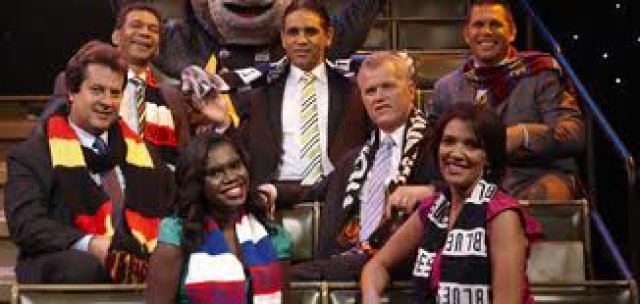
Round Nine of the Australian Football League, held from May 24-26, was designated the “Indigenous Round” in honour of Aboriginal players and culture.
However, former Age sports journalist Trevor Grant writes that, despite progress, the AFL continues to block Aboriginal access to key aspects of the sport ― on and off the field. The article is slightly abridged from Grant's website What's The Score, Sport, where more of his writings on sport and politics can be found.
* * *
For those who missed it, there was one significant new event happening while footy fans meandered through a long hot summer. The Marngrook Footy Show has been brought back from the dead by SBS TV after being killed off by the ABC.
Marngrook has made a unique contribution to AFL football as the only footy show populated by Indigenous commentators and presenters. Over several seasons, it had gathered a following of many tribes ― white, black, brindle, old, young, deaf, blind and insane ― who loved the spirit, fun, and quirkiness of a show that loved to celebrate the game as well as the huge contribution of the Indigenous community to it.
However, this meant little to the ABC, which claimed its low ratings made the costs unsustainable. Indeed, the ABC spokesperson sounded just like a commercial station boss when he announced the reasons for the demise of Marngrook.
Thankfully it is back, although with a couple of potential drawbacks. It is shown on the relatively unknown backwater of the National Indigenous TV (NITV) channel rather than the up-front main SBS channel. It has also acquired the presence of former AFL star and serial wrong-doer Wayne Carey, whose media contributions in retirement have so far been mediocre.
The Marngrook story prompted a lot of questions about the publicly funded national broadcaster and its role as a communicator of diversity and public interest rather than a ratings chaser. There is another relevant question Marngrook asks, and that is about Indigenous access to participation in the game.
Like most other white-run institutions, for most of its 116-year history the AFL has been a racist organisation. And it’s a lot more recent than those stories about the trainers at Fitzroy refusing to rub down the Aboriginal players in the 1940s.
A former recruiting officer at Hawthorn, John Turnbull, revealed in The Age in 2008 that when he arrived at the club in 1995, a senior official pointed to his own white forearm and said: “Good luck, John and just remember, don’t draft anyone with skin darker than mine.”
It is a story that resonated on the last Saturday in September last year when Hawthorn, with half a dozen Aboriginals as key players in their team through the year, almost won its second premiership in four years, just pipped by the Swans, led by Aboriginal star Adam Goodes.
Only recently, I learned that the all-Aboriginal Melbourne team, the Fitzroy Stars, had 36 rejections from various football leagues when it was trying to re-form a few years ago. Finally it was accepted in 2008 by the Northern Football League, where it now performs with great aplomb.
Still, progress on eliminating racist attitudes at AFL level has been significant, as we saw last year when Collingwood player Dale Thomas reported his own supporters to the club for racially abusing an Aboriginal opponent.
There is no question that Aboriginal access to AFL clubs is much greater these days. The AFL boasts on its website that there are 69 Aboriginal players, who account for 10% of players. There are also 90,000 participants in AFL-backed programs around the country. This is a commendable over-representation in a nation in which Aboriginal people make up only 2.5% of the population.
But this concentration on those playing the game hides the fact that there is little Indigenous participation in the AFL beyond the boundary line. The AFL Commission is made up of white, mostly Anglo-Saxon, rich business types, male and female.
The high-powered AFL executive arm is headed by an anti-racist of Greek Cypriot parents, Andrew Demetriou, but the executives under him retain the same look and feel as the Commission.
The idea of an Aboriginal coach is simply not considered and very few have been groomed or employed as assistant coaches, or as football department support staff. The unstated message is that Aboriginal players may be valuable on the field, but when it comes to running the team, it’s a white man’s domain.
Once you move to the media box, it is much the same. Beyond specialist Indigenous station broadcasters, you find a distinct lack of non-white, non Anglo-Saxon participants. In other words, what is reflected in the media in general is also reflected in the AFL.
The AFL says on its website that it seeks to use Australian football as the vehicle to improve the quality of life in communities throughout Australia. No question it is great at telling the world about its anti-racism initiatives, but it needs to show that it is more than a wonderful publicity machine.
For starters, it might do well to throw some of that new TV rights money ($1.2 billion) at the Marngrook Footy Show and bring it into the mainstream, where it belongs.
